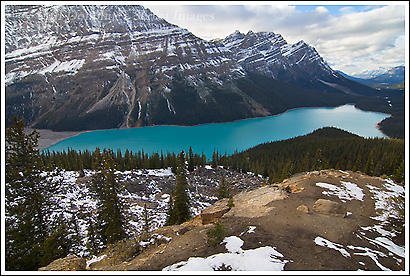Hey Folks,
I promised I’d stop with the dog-fest today, so indeed, being a man of my word, I did exactly that. Here’s a photo I shot last September on the now infamous trip thru the Canadian Rockies with my parents. This is Peyto Lake, one of the icons of the Canadian Rockies and Banff National Park. Little trivia again. Anyone care to explain the rich color of the lake? I’ll give ya a hint. It’s cold. 🙂
Cheers

I take “What color is glacial silt” for $500. For as many images that I have seen of this lake, it just never gets boring to look at, and I am sure they all pale in comparison to actually being there. I have wanted to visit Banff for some time.
Hey Mark,
Can you elaborate on the term “glacial silt”, and give an explanation of how that yields a turquoise-colored lake? And $500.00???? Excuse me? You know I don’t have a job, right?
Banff and Jasper are awesome. Get yourself over there.
Cheers
Carl
Blue dye #12 ?
I love that spot!
Well of course I can elaborate, but I didn’t want to make my answer too eco-political.
That company that makes Blue Dye #12 that Ron is referring to has a bad reputation of dumping their waste in the glacial regions of Canada. So in a way, we are both right!
Hey Ron,
No, incorrect. That’s what I use to do my hair. Close though, alas, no cigar.
Mark, Ron’s incorrigible. Don’t encourage the poor man.
Here’s what I want to know. Glacial silt, also called glacial flour, is brown or grey, not blue. Glacial-formed rivers are so silty you can’t see into the water even an inch. They’re not blue, or turquoise, but brown and grey. So what’s up?
Cheers
Carl
Well – I would think the particles absorb most wavelengths of light except for those in the blue-green spectrum. If they are moving in a river, perhaps they are not as uniform yet as they are in the lake or not able to reflect the light while moving so fast. That’s my guess, if it isn’t it – I wasn’t going to get my $500 anyway, so I give. 🙂
Hey Mark,
Kinda .. sorta.
Actually, water itself does exactly what you describe . it’s not “clear” as we were told. People used to say the blue of water like the ocean or lakes, etc was a reflection of the sky, and that’s not exactly true. Water absorbs other wavelengths, and reflects the blue-green spectrum. Cool, eh? Larger and deeper pools of water, such as the ocean reflect more, that’s why a glass of water will appear clear. The lakes do also reflect some of the sky blue, as well, that’s why they appear to be less blue on a cloudy day.
Glacial flour, or rock flour, is mostly quartz and feldspar. I think a big reason for the difference in color with lakes and glacial rivers is that a lot of the other sediment settling to the bottom in the still water. Only the glacial flour remains suspended in the water. It’s definitely very different. I can’t filter water from a dirty brown glacial river without clogging my filter almost immediately. But lakes like this one don’t clog filters nearly as quickly – so I believe that’s part of it. But mostly, you’re right, it’s the particles reflecting particular wavelengths of light.
Cheers
Carl
I’m way too late for this blog, but I had a great time & a lot of laughs just reading all of your blogs!!